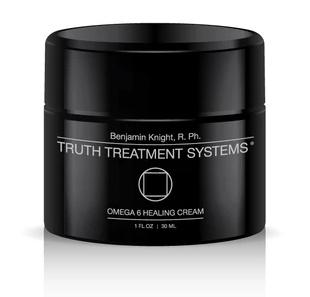
Omega 6 Healing Cream
Highlights
Key Ingredients
Skim through
| Ingredient name | what-it-does | irr., com. | ID-Rating |
|---|---|---|---|
| Jojoba Esters | soothing, emollient, moisturizer/humectant | ||
| Argan Esters | |||
| Ascorbyl Palmitate (Vitamin C) | antioxidant | 0, 2 | icky |
| C12-14 Alkyl Benzoate | |||
| Omega 6 Fatty Acid Esters | |||
| Fatty Acid Esters | |||
| C10-30 Cholesterol/Lanosterol Esters | emollient, emulsifying, viscosity controlling | goodie | |
| Essential Oil |
Truth treatments Omega 6 Healing CreamIngredients explained
Jojoba-derived emollient wax esters (fatty acid + fatty alcohol) that make your skin feel nice and smooth. Chemically speaking, pure jojoba oil is also a wax ester (read our shiny explanation here), however, the ingredients called jojoba esters on the ingredient lists are made from jojoba oil and/or hydrogenated jojoba oil via interesterification.
They have multiple versions with variable fatty acid chain length and the ingredient can have a liquid, a creamy, a soft or firm paste, or even a hard wax consistency. The common thing between all versions is, that unlike most normal triglyceride oils, jojoba esters have superior stability, provide non-greasy emolliency and are readily absorbed into the skin.
This ingredient name is not according to the INCI-standard. :( What, why?!
A form of skincare superstar, vitamin C. Even though we are massive vitamin C fans, Ascorbyl Palmitate (AP) is our least favorite. (Btw, if you do not know what the big deal with vitamin C is then you are missing out. You must go and read our geeky details about it.)
So, AP is one of the attempts by the cosmetics industry to solve the stability issues with vitamin C while preserving its benefits, but it seems to fall short on several things.

This ingredient name is not according to the INCI-standard. :( What, why?!
This ingredient name is not according to the INCI-standard. :( What, why?!
A clear, pale yellow oil-like liquid that's claimed to be similar to the lipids that are naturally in the outermost layer of the skin. It's not only similar to them but it is also biomimetic, meaning that it can mimic the functionality of our skin lipids.
The skin lipids play a super important role in maintaining a healthy skin barrier and keeping the skin nice and moisturized and not dry or cracked. So C10-30 Cholesterol/Lanosterol Esters, aka Super Sterol Liquid can do something similar: it is an extremely efficient emollient that can repair even dry hands or cracked lips and it is great at maintaining a healthy skin barrier.
This ingredient name is not according to the INCI-standard. :( What, why?!
You may also want to take a look at...
| what‑it‑does | soothing | emollient | moisturizer/humectant |
| what‑it‑does | antioxidant |
| irritancy, com. | 0, 2 |
| what‑it‑does | emollient | emulsifying | viscosity controlling |





